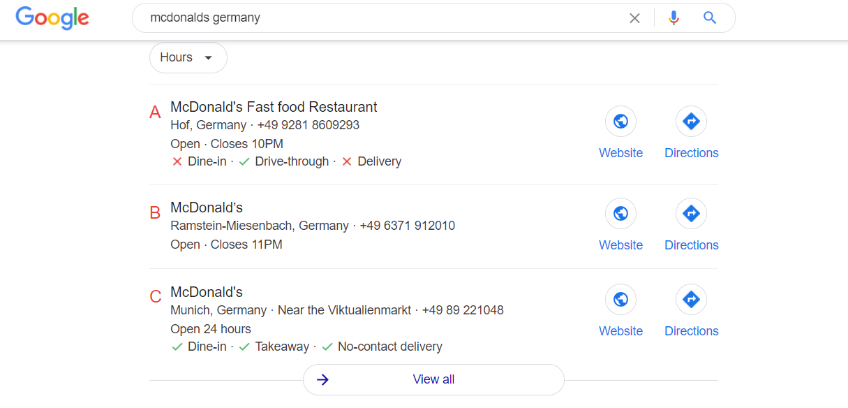For businesses that have a website audience outside their home country or want to expand their offerings to a global market, having a well-thought-out international SEO strategy can pay off big time.
As complicated as the process may seem, making your website international SEO friendly boils down to how well you understand your business goals. If you know what type of website structure best suits your audience for example, and whether or not you are willing to invest resources to optimize for it accordingly, your international SEO will consequently become easier to implement.
In this guide, I will run you through all the best practices that you need to keep in mind to have a global visibility for your website.
Let’s kick things off by understanding what international SEO is.
What is International SEO?
As the name suggests, international SEO involves all the activities you do to have an optimized website for people who are outside your local country or who speak a different language.
Essentially, the big stuff on your website i.e. your domain/ brand name, your products/services, About Us information, etc. remain the same. But a good international SEO strategy ensures that there are customizations done where they are needed the most. This may include everything from your brand messaging, the language you use, to the user experience you offer and so on.
Who Needs To Do International SEO?
Naturally, every website would want to have a wider audience base. But it is important to understand how well-prepared a business is for an international expansion. For businesses that are relatively new and still figuring out the logistics in their home country, focusing on global markets may not be ideal.
Apart from this, expanding to a new region in the hopes of capturing a wider market share without conducting proper research with regards to the consumer behavior and demand for the products to be offered can again be a costly mistake.
So the best way to gauge if focusing on international SEO is viable for your website is to use Google Analytics to see how many users you have in each region.

Once you know which countries are most interested in your website and (what language the users speak), it will then be easier to prioritize your international SEO efforts towards those specific regions.
On the other hand, if you want to do international SEO to target specific regions despite your website not having great visibility there, you can still do that but it would require more time and resources from your end.
Best Practices In Implementing An International SEO Strategy
International SEO works quite similar to geotargeting, in that, with geotargeting you optimize according to different areas or cities within your target location whereas, with international SEO, your optimizations are based on the languages or locations outside your original target market.
There are some optimizations that you will need to do to make your website more welcoming for audiences in different areas speaking different languages.
So in this section, we will be discussing all the best practices that you will need to consider to have a website that is SEO-friendly for an international audience.
Identify The Type Of Content You Want To Provide
As mentioned at the start of this blog, international SEO depends largely on the objectives of your SEO. Therefore the first step is to decide the type of content you want your international audience to see.
Is your aim to establish your website in a specific country or would you like to simply focus on delivering your website content in different languages? There is also an option of targeting both locations and languages.
For example, eBay has different versions of its website for different countries appearing in different languages.

Whenever customers click on a specific country, they are directed to another version of the website which has offerings and content exclusive to that country in their language.

Of course, there are cases where you will prioritize language targeting over location targeting. For example, if you have a business selling mug art in the Spanish language, you would be targeting the Spanish language without focusing on any specific region since Spanish is spoken in different countries like Mexico, Spain, the US, etc.
Again, you can check which countries is your website generating the most traffic from and also see what languages your audience speaks to make better decisions.
Select The Most Suitable Domain Structure
To target users from a specific country, you will need to set up an SEO-friendly URL structure for your website. This ensures that, for example, users from Finland only view a version that is most suitable to their own needs and likings.
There are primarily three options for you to choose from:
- A subdirectory for each country
- A subdomain for each country
- A separate Country Code Top-Level Domain (ccTLD) for each country
Let’s discuss each of these options and their implications in more depth.
A Subdirectory For Each Country
Each domain has a subdirectory. Notice that this blog is also placed on a subdirectory “Guide to International SEO” of the root domain “linkbuildinghq.com”. Similarly, websites can have separate subdirectories for each country that they are targeting.
For example, Standard Chartered Bank’s root domain is sc.com. To target people in the UK, its website has a subdirectory sc.com/uk/.

Notice that the subdirectory will always follow the generic top-level domain gTLD which is a “.com,” “.org,” “.inc,” and so on.
Each country has its own two-letter ISO code. And if there are countries in which there are multiple languages spoken, and you would want to target those as well, you can add the language code next to the location code.
For example, a root domain targeting both English and French speakers in Canada will be “domain.com/en-ca” and “domain.com/fr-ca,” respectively, with the language code coming before the country code.

The subdirectory structure is ideal in most cases since it is easier to set up and doesn’t cost much to maintain either. Apart from this, the domain authority will also flow to your subdirectories, which is not the case if you go for a ccTLD. Finally, if you decide to update your sites, all of your redirects will be in one place, and you will not be required to do that for each site.
One downside with subdirectories is that it is a relatively weaker international SEO signal than a separate website for each country.
A Subdomain For Each Country
Another option for your international website’s URL structure is using a subdomain for targeted countries.
Here, the targeted country or language code will appear before the generic top-level domain gTLD.
This is something that Wikipedia uses for its website.

So, while Subdomains are also easy to set up, can be hosted on different servers, and provide the needed geotargeting signals to search engines, when compared with subdirectories, they are more expensive in implementation.
Separate Country Code Top-Level Domain (ccTLD)
International websites can also opt for a country-code Top-Level Domain (ccTLD). Here, companies will set up a separate website for users for each of the targeted countries.
For example, the Adidas Australia website is “adidas.com.au”. Notice that, unlike the subdomain, here the country code “au” comes after the gTLD “.com”.

Some country codes like “.co” which is used for Colombia are common and therefore are open to being registered for other purposes like making a “domain.co” website where the “co” represents “company”.
With a separate domain for each country, the international SEO signal is much more powerful, and it also tells users and search engines that the company has a dedicated presence in that particular region, helping with building more trust.
However, again, maintaining separate websites is costly, time-consuming, and not good link building since the domain authority is restricted to each domain.
Here is an infographic from Moz that lists the pros and cons of each website structure.
Using Hreflang Tags
With the help of the Hreflang meta tags, search engines can know which languages the website needs to be in as per the needs of the users.
The content doesn’t have to be different, and so, to make sure the same pages are not competing against each other in rankings, the hreflang tags are used.
To specify which language to use, ISO 639 codes are used, whereas ISO 3166 codes are used to specify which country the website is for.
Hreflang also helps in reducing bounce rates and increasing conversions because the target audience is served a local version of a website.
Hreflang can be placed in either the HTTP headers of every page, the HTML tags, or the sitemap.
Here is an example of what the hreflang can look like:
The link rel=“alternate” means that the link contained in the code is another version of this page.
The hreflang=“en-US” is targeting English speakers in the US.
The href=“https://example.com/alternate-page” is the web address for the alternate page.
To ask users about their preferred page, the x-default can be handy since it shows that the page does not target any specific location. Here is a code that you can use:
<link rel=”alternate” href=”http://example.com/” hreflang=”x-default” />
Improving On Other SEO Signals
Apart from the website structure and hreflang tags, there are other equally important SEO factors that you need to keep in mind to boost your website’s visibility. In this section, we will be discussing four factors that will particularly help your website’s international SEO.
International SEO Keyword Research
One common pitfall to avoid while doing international keyword research is relying on machine translations of your original content. They may not seem natural to the local readers and can also be inaccurate.
There are many tools that can help you with your keyword research. If you can get a paid tool, Ahrefs can be a good choice. It tells you things like a keyword’s search volume, ranking difficulty, CPC, and so on in your targeted countries.

Other tools that provide international data for keywords include Google Keywords Planner, SEMrush, Keyword Tool.io and Rank Tracker.
Read our blog on keyword research to know everything you need to do to get a refined list of keywords.
Localized Link Building
Link building remains one of the most important parts of any SEO strategy. This holds true for your international SEO as well. If you are opting for a ccTLD website structure, then your link building efforts need more focus. It may also take time, as you will need to build up authority from scratch.
Generally, link building for international markets is a bit more time-consuming. The reason? Language constraints, difference in competitive environments, and unique audiences.
You can first look for links that point to your original website from countries where you intend to establish your website. Again, use Ahrefs to see your current backlink profile, reach out to websites from different countries, and ask them to link to your local website.
Looking at the link profiles of your local competitors will also allow you to reach out to those linking websites for your own local website.
Apart from this, traditional link building techniques like guest posting, publishing interviews on local websites, broken link building, influencer outreach, and including local website links in your social media pages all work just fine. Here is a complete guide to link building that will be super useful for you.
Optimize For Local Search Engines
While Google is the most popular search engine worldwide with over 92% search market share, other search engines are more popular in specific countries. For example, Baidu is a popular choice for people in China, whereas Yandex is more used in Russia and Eastern European countries, and Naver is a leading search engine in South Korea.
So while optimization principles are mostly the same, you must know which search engine’s ranking matters the most to you in each location.

Structured Data
Everything from your phone numbers and opening hours to local addresses and pricing needs to be customized for the local audience and to show them in the local searches. For this, the use of schema markups is vital.
Schema.org, which is the collection of all structured data markup, is a collective effort from different search engines, including Google, Yandex, Yahoo, and Bing. This means all schemas that you apply can be used to communicate to these search engines.
The most useful schema markup in appearing for local searches include the Organization and LocalBusiness markups. They can be easily implemented using the Structured Data Markup Helper tool.

Let’s Wrap It Up
The main principles of SEO apply to international SEO, too. The best advice is to understand the needs of the local audience and the competitive landscape. This way, you will be able to make customizations in your content, user experience, and offerings.
Like SEO in general, international SEO will take time. You will have to implement meticulous planning to ensure all versions of your website run smoothly and have a fair chance of appearing higher in the local rankings.











